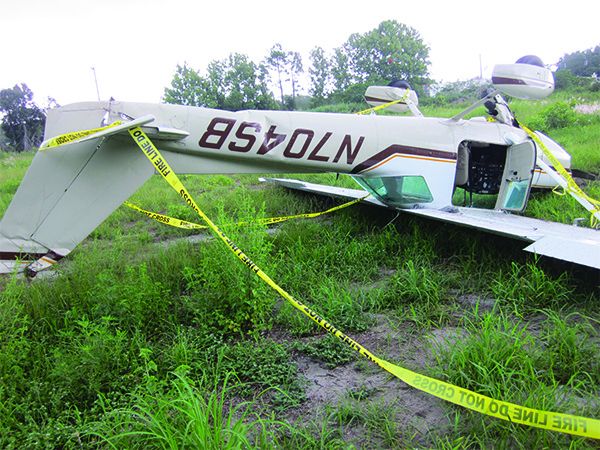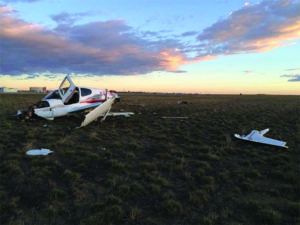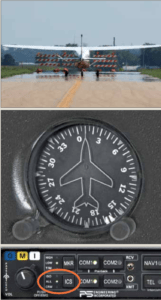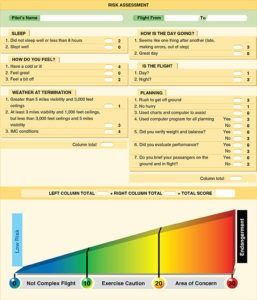
Every certificated pilot has had the pleasure of flying with the FAA or an agency-designated pilot examiner. It can be a stressful experience. The plane, the pilot and the preparation are all under a higher level of scrutiny than on a normal flight. You want to do everything right, and generally portray yourself as a risk-averse pilot on this flight, even if you might not be. There’s the pass/fail element also, and you’ve spent a lot of time and money to get ready for this moment. You don’t want to blow it. While every flight will not contain the same pressures as a checkride, the stakes are always as high, if not higher.
Treating each flight, from preflight preparation to parking, as if the FAA is sitting over your shoulder can be one of the most effective methods of combating hazardous attitudes. Throughout the planning, preflight and in-flight phases, the “one weird trick” of asking yourself two simple questions can help combat unsafe attitudes and prevent the normalization of deviance in your everyday flying. The first question to ask yourself is: “Would I do this if the FAA was on board?”
IF THE FAA WAS ABOARD
Consider a simple flighty hopefully every pilot has experienced; the evening joyride to enjoy the views at altitude with friends or family. Your passenger arrives early, and you rush the planning to show them the airplane and get going. It is a beautiful day anyway, with clear skies and light winds. You take off, and give the tour of the best sights around. During the flight, your passenger mentions he actually grew up next to Bill’s Airport Shack, and you decide to land there for a trip down memory lane. You didn’t check the Notams for the airport, but going in for a quick full-stop and taxi-back shouldn’t be an issue, right?
Odds are, nothing bad will happen. The airport and runway of intended use probably won’t be closed, and there probably was not any undue hazard in making this unintended stop. But pilots have landed at closed airports and on closed runways, and despite the FAA’s and industry’s constant battles, pilots still take off without checking Notams.
Now, think back to your most recent checkride. Would you have ever landed at that airport with the FAA aboard without making 100-percent sure you checked any and all Notams?
One of the important lessons I learned when switching back and forth from a crewed environment to single-pilot flying was how comfortable we can become when flying by ourselves or flying without another aviator up front. When you have flown the same airplane for a number of hours, the checklists get memorized, the procedures become second-hand and the seat gets very comfortable. Another word for this “comfort” is complacency, which can be defined as satisfaction with a situation to the extent that the degradation of vigilance occurs. The phrase “degradation of vigilance” is key. A good instructor, another crewmember up front or even just a pilot buddy can challenge you on any bad habits that might have developed. In the event you do not have this opportunity, you can continually ask yourself, “Would I do this if the FAA was on board?”
Answering this question can stop a lot of those links in the accident chain from forming. If the FAA was on board, would you skip that weather briefing? Would you take off with that iffy mag check? Would you accept that short approach when you may not have been in an ideal position to do so? Recognizing these links before they occur is critical and requires self-awareness and self-discipline to avoid their pitfalls. Which segues nicely into the second question.

According to the FAA’s web site, the top 10 leading causes of fatal general aviation accidents from 2001 to 2016 are:
1. Loss of Control–Inflight
2. Controlled Flight Into Terrain
3. System Component Failure–Powerplant
4. Fuel Related
5. Unknown or Undetermined
6. System Component Failure–Non-Powerplant
7. Unintended Flight In IMC
8. Midair Collisions
9. Low-Altitude Operations
10. Other
Very rarely does a flight depart and it was doomed from the start. Almost always, there was a series of critical points where a pilot elected to continue when it would have been prudent to stop, discontinue, divert, go around, et cetera. The first step is recognizing the problem.
FOR THE RECORD
Which is, “Would this decision end up on the accident report?” Another way to get the point across would be to ask, “How will you defend this decision at the NTSB hearing?” Definitely a bit morbid, but one of the most useful tools for the modern safe pilot is the NTSB’s world-standard post-accident investigation and analysis. Simply put, it is much safer to learn from the mistakes of others than to make them yourself. That’s one of the reasons you read this magazine.
The FAA has created myriad acronyms to unveil and combat this “first link” before it leads down the path toward greater hazard. Some examples of these are the DECIDE and 3P models, PAVE, IMSAFE and probably about a dozen other nuggets buried in our hopefully not-too-dusty copies of the Pilot’s Handbook of Aeronautical Knowledge, or PHAK.
Without preaching Chapter Two (aeronautical decision-making) too heavily, it’s a great starting point for managing risk in the real world. In training, it’s easy to manage risk. First, you’re flying with a (hopefully) current and experienced flight instructor. Two, the push to complete the mission just is not as strong. You are already at the airport where your car is, and you have blocked the time out for a lesson, so you shouldn’t be missing anything important. Plus, there is always ground work to do as a student, right? So often, the first time a pilot is truly exercising their risk assessment and ADM skills is out in the wild, with some challenging external pressures. This is frequently where you will find the first step down the path toward misfortune.
A large chunk of an accident report covers facts, conditions and circumstances that occur well before takeoff. The pilot’s training, currency, rest, mission and background information are extensively reviewed. Usually there’s a contributing factor laid out in this phase of flight, prior to takeoff or even entering the aircraft. Combining those factors with snap decisions made during critical phases of flight can present challenges to even the most skilled aviators.
For example, and since scenario-based risk management is all the rage, consider the following scenario. At each step, ask the question, “Would this decision end up in the accident report?”
A pilot is with his family on a weekend trip. Their intended departure time was 1500 local, but there is some weather coming in. To beat the weather, they rushed to the airport and expedited their preflight process. The pilot departed IFR two hours early after an abbreviated weather briefing. Once the pilot is in a rushing mood, it is hard to shake. Did the pilot carefully review the ODP prior to departing the uncontrolled field IFR?
While in cruise, ATC advises the pilot that there were reports of light icing at their cruising altitude. Did the abbreviated briefing include the freezing levels? If the aircraft is approved for flight into known icing, did the pilot check that the equipment was functioning prior to entering icing conditions?
The pilot decides to divert to avoid icing conditions. Eager to get on the ground, the approach briefing is rushed and obtaining the weather falls by the wayside. The above scenario is not unrealistic. If you review the FAA’s leading cause of fatal accidents, three or four of those factors could easily occur at any phase of that flight. If the pilot stopped to ask him or herself, “Would this decision end up in the accident report?” could that scenario have ended differently? I would like to think so.

In Advisory Circular AC 120-71B, “Standard Operating Procedures and Pilot Monitoring Duties for Flight Deck Crewmembers,” the FAA states that “SOPs are universally recognized as fundamental to safe aviation operations. Their importance cannot be overstated, especially in light of the…use of increasingly modernized automated systems.” Here are some example SOPs that can help prevent hazards before they develop.
Heads-Up Taxiing
Seems obvious, but runway and taxiway incursions still happen. Even a minor wingtip strike can ruin a great weekend. Copying clearances, adjusting EFBs and remembering to turn airplane mode on can wait until the aircraft is at a complete stop. It might not be a bad idea to have the airport diagram out, too.
1000 Feet To Go
Doesn’t it seem like all the distractions pop up when you are getting close to leveling out?
500 Feet
Calling out 500 feet prior to landing, in addition to some crucial final checks (gear down, on-speed, cleared to land) can be your safety net if a non-standard approach interferes with a GUMPS check.
Heading Checks for Runway
Whether landing or taking off, one last heading check can prevent a serious incursion. If you have a heading bug, line it up.
Sterile Cockpit
Sterile cockpit procedures prohibit non-essential activities critical phases of flight, including non-pertinent conversation. This can be particularly hard, especially with excited passengers. Set boundaries, and hold off on responding to questions during taxi, takeoff and landing. Don’t forget the isolate switch available on many modern audio panels.
TOOLS YOU CAN USE
So, what tools are at our disposal? Every flight has risk, and what is the fun of getting these ratings if you cannot use them to complete missions? Many of the tools professional pilots use can be game changers for GA pilots.
Training: How proficient are you? Professional pilots typically train and complete checkrides every six months, whereas a private pilot can land three times every 90 days and complete one flight review every two years and be completely legal. It is a worthy endeavor to expand your skills with an instructor, or even an experienced co-pilot, even if it is only once every six months.
FRATS: Flight Risk Assessment Tools have been a staple in safety management for a long time. Typically, airlines or corporate outfits will make a custom flight risk assessment tool pertaining to their operation, but the FAA and NBAA provide great general tools. They can provide an objective assessment of the risk you are assuming.
SOPs: Standard Operating Procedures help the practical pilot stay safe in normal and abnormal operations. Consistent checklist usage, quality briefings and callouts (even if it is just to yourself) can help you stay ahead of the airplane and out of trouble.
Personal Minimums: Pushing the envelope can present undue risk. Similar to the FRAT, setting personal minimums is a fantastic way to objectively define go/no-go decisions. If you utilize your pilot certificate for any missions that are difficult to say no to (weekend trips, work commutes), it can get easier and easier to talk yourself into completing the mission. It is not easy to complete all the training required to become a pilot, but sometimes the best use of all that training is a safe decision to drive.
Consistently operating an aircraft safely requires a lot of discipline and can frequently end in a disappointing result (like driving). Asking yourself, “Would I do this if the FAA was on board?” can keep you out of trouble and could really save you if you are the victim of a dreaded ramp check. Asking yourself, “Would this decision end up in the accident report?” just may keep you out of one.

While Flight Risk Assessment Tools may seem like a hassle to the typical paperwork-averse pilot, they can serve a valuable purpose in preflight planning. First, they serve as a nice checklist for high-risk items. When “flight into icing conditions” pops up, especially if your aircraft is not certified for flight into known icing, it could be the trigger to double-check those freezing levels. Additionally, it can serve as an eye opener when stacking up hazards for an important mission. Individually, marginal VFR, turbulence and night operations might not cause any issues, but combining them may push the flight into an unacceptable risk level.
FRATs are an excellent resource but have to be used in conjunction with good ADM. A FRAT score may fall numerically into the “safe” range, and the flight still might be above your risk tolerance. That is perfectly acceptable. The most important thing is not manipulating the numbers to fall into a certain category. If you are tempted to do this, it is important to evaluate how external pressures may be clouding the decision-making process.
At right, the FAA’s FRAT is found in the Risk Management Handbook (FAA-H-8083-2).
Ryan Motte is a Massachusetts-based Part 135 pilot, flight instructor and check airman. He moonlights as Director of Safety when he isn’t flying.



